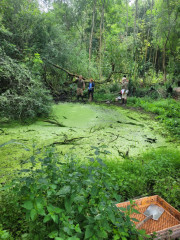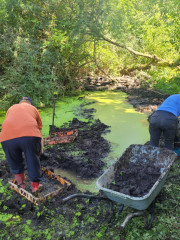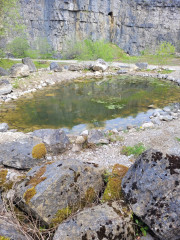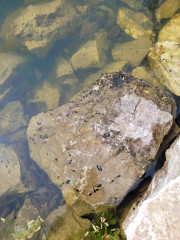About us
About Us
Welcome to Derbyshire Amphibian and Reptile Group we cover the whole of Derbyshire including part of the Peak District National Park.and the National Forest
Our group aims to promote the study and conservation of the amphibians and reptiles of Derbyshire and their habitats. We achieve this by:
- raising awareness of the ecology and conservation needs of Derbyshire's amphibians and reptiles
- undertaking practical conservation projects
- running approximately 20 Toads on Road patrols at locations across the county every spring during the toad migration season
- carrying out regular reptile surveys and amphibian surveys
- organising amphibian and reptile training sessions for members and the public
- providing advice and information and answering queries for the public
- developing recording, monitoring and research intitatives
- providing a forum for those interested in amphibians and reptiles
- working in partnership with other relevant organisations
We hope our website will help you to find the information you are looking for, but if you still have a query, please contact us and we will do our best to help.
Derbyshire ARG always welcome new members to the group, please email us on derbyshirearg@gmail.com to join. There is a membership subscription of £5 per year, though that is reviewed at every AGM..
We are very grateful for any records of amphibians and reptiles in your local area that you can pass to us as it helps in mapping the distribution of species and protecting their known habitats. Either contact us directly or use the Record a sighting tab on this website.
The group is run by a committee which is elected at the AGM each year. For 2025 - 2026 the committee re-elected at the AGM on 18th October 2025 are:
Chair - Kelvin Lawrence, Vice Chair - Christian Murray-Leslie, Secretary - Chris Monk, Treasurer - Jayne Thompson
Committee members - Garry Dorrell, Chris Hallam, James Longley, Sheila Stubbs and Ben Wyke
Kelvin Lawrence is also the Derbyshire Toad Crossings Co-ordinator for the Group & for Froglife
See a previous newsletters here
![]() January_2021_DARG_newsletter_31.pdf
January_2021_DARG_newsletter_31.pdf
![]() August_2020_DerbyshireARG_newsletter.pdf
August_2020_DerbyshireARG_newsletter.pdf
![]() February_2020_DARG_Events_newsletter.pdf
February_2020_DARG_Events_newsletter.pdf
![]() DARG_April_2019_newsletter.pdf
DARG_April_2019_newsletter.pdf
![]() DARG_January_2019_newsletter.pdf
DARG_January_2019_newsletter.pdf
Derbyshire ARG data policy
![]() DARG_data_protection_policy_November_2018.pdf
DARG_data_protection_policy_November_2018.pdf
News
News
DaNES Show 8th November 2025
Together with Notts ARG we again attended the annual Derbyshire and Nottinghamshire Entomological Society's Show at the Brackenhurst Campus of Nottingham Trent University. It was well attended with 500 people attending. We & Notts ARG were very busy talking to attendees but still managed to find a rare slow gap just before 2.00pm to take some photos of the stands
This was the last of the public events we attended this year after earlier ones at Pleasley Pit Wildlife Day, the Bakewell Countryside Festival and the Buxton Green Assembly.



Work at Rosliston Forestry Centre
Derbyshire ARG organised a series of amphibian surveys in 2023 covering some of the ponds at various sites in the National Forest. One of the sites we visited was the Rosliston Forestry Centre that was created in the 1990s on an area of farmland including some hedgerows & small woodlands. As well as some new ponds there were a few old field ponds incorporated into the site, most of which by now were in a very poor state. This year in conjunction with the Forestry Centre and Burton Conservation Volunteers we have helped with work parties mostly on Pond 2. This pond was very overshadowed by trees, extremely silted up and prone to drying out but also had the most frog spawn clumps in our 2023 survey. Work this February concentrated on removing some of the problem trees and it was discovered that the low water level was due to a fallen willow that had brought down the pond bank, so the pond never filled up to the outfall pipe.
Yesterday's August working party initially concentrated on rebuilding the pond bank, filling the erosion void with silt and revetting the bank with a wall of wall of hessian sand bags filled with silt. Once that was done the rest of the worki concentrated on digging out some of the silt. This had to be done by DARG & BCV volunteers as there is no way to get machinery through the trees to the pond site.

Pond 2 before work in August 2025

Rebuilt area of pond bank

Hard work desilting by hand
Stanage & North Lees lizard surveys
At the 2024 Stanage Forum open meeting in October we reported the findings from our surveys on the estate. Only just over 50% of the surveys went ahead with the others being cancelled due to poor weather (rain, overcast conditions, hill fog and extreme heat) 2 surveys went ahead but the forecast sunshine never made an appearance, whilst just one survey in October 2024 had suitable weather but no lizards were seen. Having divided up the large estate into 11 zones where we thought lizards would be present we have now confirmed that they are present in every zone area. Further surveys will be undertaken in 2025 to examine some of teh areas in more detail.



Rewilding success at British Mountaineering Council owned Horseshoe Quarry
After Derbyshire ARG did surveys this year at Horseshoe Quarry the BMC have published the attached article https://www.thebmc.co.uk/rewilding-success-horseshoe-quarry-2024
Horseshoe Quarry, also known as Furness Quarry, is a large, disused limestone quarry in Stoney Middleton, Peak District with a long history of climbing and owned by the BMC since 2005. Almost three decades on, rewilding at the site has already been fantastically successful, with hundreds of newts and toad tadpoles spotted in the pond this spring.
 Horseshoe Quarry pond (left) Toad tadpoles just hatched in 2024 (right)
Horseshoe Quarry pond (left) Toad tadpoles just hatched in 2024 (right) 
A short history of Horseshoe Quarry
Although climbers snuck in anyway, there was originally no CROW access to Horseshoe Quarry. So, in 2005 the BMC purchased an 8.5ha area of the site to secure access to walkers, climbers and cavers in perpetuity. Alongside this, a local management group was created to care for the area and promote local botanical and ecological interests, because the land lies within a Site of Special Scientific Interest (SSSI).
Over the years there has been a great deal of rewilding work at Horseshoe Quarry including footpath improvement, the creation of a wildlife pond, ecological surveys, woodland management and control of invasive species. So much so that this former quarry has become a highly reputable recreational and environmental asset.
In 2007 the Vision Project funded the creation of a wildlife pond to the south of the quarry floor, which is now teaming with wildlife, as Chris Monk, secretary of the Derbyshire Amphibian and Reptile Group (ARG) discovered this spring.
Rewilding: latest update
Chris Monk, secretary of the Derbyshire Amphibian and Reptile Group shares the good news.
What were the amphibian and reptile counts like before this restoration work?
Initially there was no pond in the quarry but a small area of shallow water that collected on the quarry floor and was used by amphibians. However these pools dried up in summer most years so the amphibian tadpoles would die. I was asked By the Peak District National Park Authority (PDNPA) staff in May 2006 to survey the quarry and other ponds in the area for their Vision Project. This revealed just over 30 smooth newts, some frogspawn and toad spawn strings in the shallow pools.
How has the site improved for amphibians and reptiles?
The PDNPA asked Henry Folkard [award-winning BMC Peak District volunteer and tireless access campaigner] whether they could include the quarry in their new Proliferating Ponds in the Peak funding bid to have a completely new pond constructed. The funding bid was successful and work to build the pond started in spring 2007. It was built close to the pools on the quarry floor so that the amphibians could easily find it and a survey in 2008 found smooth newts in the new pond with none in the shallow pools.
Over the years the amphibian population based around the pond has grown as there is now no risk of summer desiccation of the tadpoles. Also the pond has been colonised by great crested newts, so the pond is now used by all four amphibian species that are found across the White Peak.
What will you do with the survey information you collected?
The survey results are passed to the BMC and PDNPA, so that such a good amphibian population, especially with the presence of the legally protected great crested newt, is on record and is taken into account when considering management of the site.
How can BMC members and climbers using Horseshoe Quarry help maintain this improvement in wildlife?
By taking care when at the site to not disturb the boulders and rock piles in the old quarry as that could result in hiding amphibians being crushed or buried. Also by not introducing any plants or animals into the pond. Thank you.
Anything else to mention?
Little is known about reptiles in the area - a single grass snake was seen in the quarry in 2009 by Henry Folkard, but they range quite widely so it was probably just assessing the location. Slow-worms and common lizards could be present in or near the quarry but they are often difficult to spot. If anyone sees a reptile then please report it to the BMC and the PDNPA ecologists.
The initial pond work was funded by Derbyshire Aggregates Levy Grant Scheme (DALGS), which also funded the woodland walkway and link to the PROW down the Dale to the east. The recent pond renovation was funded via FiPL (Farming in Protected Landscapes).
The May 2024 survey of the pond by the Derbyshire Amphibian & Reptile Group counted 241 smooth newts, 14 great crested newts and thousands of toad tadpoles. The disused quarry is obviously an ideal location for amphibians with a good pond for breeding and excellent terrestrial habitat with its loose rock piles providing a mass of resting and hibernating locations for them.
2023 Surveys and Events
The Group's outdoor programme has now finished for this year, though we are attending one more indoor event in November and hope to set up an indoor members meeting & AGM in January or February..
The pond surveys carried out in the Peak District in the north of the county and in the National Forest in the south of the county were sucessful in involving a large number of members. They resulted in updated and new records of all 5 species of amphibians native to the county (common frog, common toad, smooth newt, palmate newt and great crested newt).The findings were reported to the landowners, Peak District National Park Authority, farmers and detailed site survey reports were done for the Derbyshire Wildlife Trust, the National Forest Company, the Woodland Trust and the Rosliston Forestry Centre (run by South Derbyshire District Council and Forestry England).
Members and local residents/volunteers participated in the toad crossing patrols at many sites across the county and adder emergence surveys were carried out in the Peak District as happens every year.
Reptile surveys were carried out at our two cover object survey sites at Hassop and at Linacre with sightings of common lizard, slow-worm and grass snake. Initially this year looked as though it would continue the run of cancellations due to bad weather for the Stanage visual surveys at North Lees after a run of 5 cancellations starting last year and again this spring & early summer. Eventually in August & early September we had better luck and actually managed to get out, survey and find lots of common lizards, including the first records from one of the moorland sites. We hope to get SSSI permissions for installing some cover object arrays next year in areas away from public pressure in the hope of finding some of the elusive snakes reported up there and for evidence of slow-worms. Meetings and advice were given to the National Trust about surveys and habitat works that could be undertaken on one of their sites that has an important grass snake population.
Our stall and display were taken to two public events this year, we were invited to the Friends of Pleasley Pit's Wildlife Day at the Pleasley Pit Country Park in May and in mid September we again attended the annual Derbyshire Woodland Festival at Elvaston Castle Country Park, The latter managed to avoid the rain, which turned up just after it closed on the second day and we spoke to numerous people about our native reptiles and amphibians and took many records of casual sightings people had made in their garden or out in the countryside.

Our stand at the Woodland Festival
Events
Events
Past Events
Show Upcoming EventsReptile field survey visit
Sat 30th April, 2016
Field visit to record reptiles at one of our survey sites at Cromford, starting at 9.45am and lasting just under 2 hours. Contact us at derbyshirearg@gmail.com to find out details of meeting place in nearby car park, as event may be cancelled if there is bad weather. (Last year's April visit co-incided with a thunderstorm!)
Great Crested Newt ecology and survey training course
Sat 14th May, 2016
A two day course at Hilton in South Derbyshire, starting at 10.30am on Saturday including field survey work in the afternoon and evening finishing at 11.15pm. Morning session on Sunday 15 May finishing around 11am.
Cost £25.00 (or £5.00 for members of Derbyshire ARG before 1st March 2016)
This training course is suitable for those wishing to work towards a Natural England GCN survey class license. It will include netting, egg searching, bottle trapping and torchlight surveys and information and demonstration of GCN eDNA sampling.
Please contact us at derbyshirearg@gmail.com for inquiries or to book a place.
GCN eDNA survey
Sat 28th May, 2016
Field visit as part of the Freshwater Habitats Trust's PondNet project to take eDNA water samples for testing for presence of great crested newts in ponds at Pilsley near Hartington in the Peak District National Park. Contact us on derbyshirearg@gmail.com to book a place and receive details of time and meeting place.
Pleasley Pit Country Park Wildlife Day
Sun 5th June, 2016
We will be having a stand at this all day event organised by the Pleasley Pit Nature Study Group at this important Local Nature Reserve which supports good populations of amphibians and reptiles. 10.00am to 4.00pm
Reptile field survey visit
Sat 11th June, 2016
CANCELLED TODAY DUE TO WEATHER - TO BE RE-ARRANGED
Field visit to record reptiles at one of our survey sites near Hassop in the Peak District National Park, meeting at 9.15am and lasting just under 2 hours. Contact us at derbyshirearg@gmail.com to find out details of meeting place in nearby car park, as event may be cancelled if there is bad weather. Note this site has a very steep slope in parts with loose scree and to access most of the location it requires a climb over a stock fence topped with barbed wire. Therefore suitable footware and agility is required to take part.
Pond dipping at The Avenue Washlands Nature Reserve
Sat 2nd July, 2016
The Avenue Washlands Nature Reserve, Mill Lane, Wingerworth
We will be running pond dipping sessions and having a stand at the Derbyshire Wildlife Trust’s "A Venue for Wildlife" event at this reserve which as an important site for amphibians and reptiles. 10.00am to 4.00pm
Derbyshire Woodland Festival
Sat 24th September, 2016 - Sun 25th September, 2016
Derbyshire ARG will be having our stand at this popular weekend show organised by the County Council's Countryside Service at the wonderful Elvaston Castle Country Park just outside Derby. Come along and visit us, tell us about your sightings of amphibians and reptiles, learn more about them, colour in the ARGUK colouring sheets (for children of all ages). Entry free but car parking charge applies. Open from 10am to 4pm both days
Pond conservation work
Sat 29th October, 2016
Morning event from 10.00 to 13.00 to rake out invading Glyceria and do a little silt clearance from dewpond that supports newts, frogs and toads near Hartington. Tools will be provided. Meeting place Hartington Station car park on the Tissington Trail between Ashbourne and Buxton. Please let us know that you will be coming and find out extra details by emailing derbyshirearg@gmail.com.
Toad crossing patrols
Wed 1st March, 2017 - Sat 15th April, 2017
Approximate dates for 2017 toad patrols helping toads across the road at around 20 sites across Derbyshire. If you would like to assist let us know and we will put you in contact with the nearest patrol.
AGM & Spring meeting
Sat 4th March, 2017
Derbyshire ARG spring meeting and AGM
Will be held at The Whistlestop Centre Education building, Matlock Bath Station, Derbyshire from 2pm to 4.30pm
Talk by Kevin Palmer of Reaseheath College on research projects on adders and grass snakes. Highlights from last October's Vanishing Viper adder meeting and a presentation on the proposals from Natural England for District Level Licensing that were shown at the 2017 Herpetofauna Workers Meeting followed by the AGM which usually lasts for no more than 15 minutes!
Group Membership
Group Membership
Derbyshire ARG will be introducing an annual membership fee in 2025.
It is planned to come into affect in the spring at a rate of £5.00
Further details to follow.
Photo gallery
Photo Gallery
Contact us
Contact Us
DerbysARG
Matlock
Derbyshire
DE4 4NF
For Toad Crossings and to contact our Derbyshire Toad Crossings Co-ordinator please email derbyshirearg.toads@gmail.com
Upcoming Events
Upcoming events will be listed here.
Latest News
- DaNES Show 8th November 2025
09/11/2025 12:40 pm - Work at Rosliston Forestry Centre
03/08/2025 12:00 pm - Stanage & North Lees lizard surveys
25/10/2024 9:33 am - Rewilding success at British Mountaineering Council owned Horseshoe Quarry
15/06/2024 3:37 pm - 2023 Surveys and Events
22/09/2023 5:00 pm
© Derbyshire Amphibian and Reptile Group
Website hits: 47764
View All | Find out how to get a mini-website for your ARG
© ARG UK Local Groups mini-websites 2026
Wind powered websites by Aye-aye Design.

